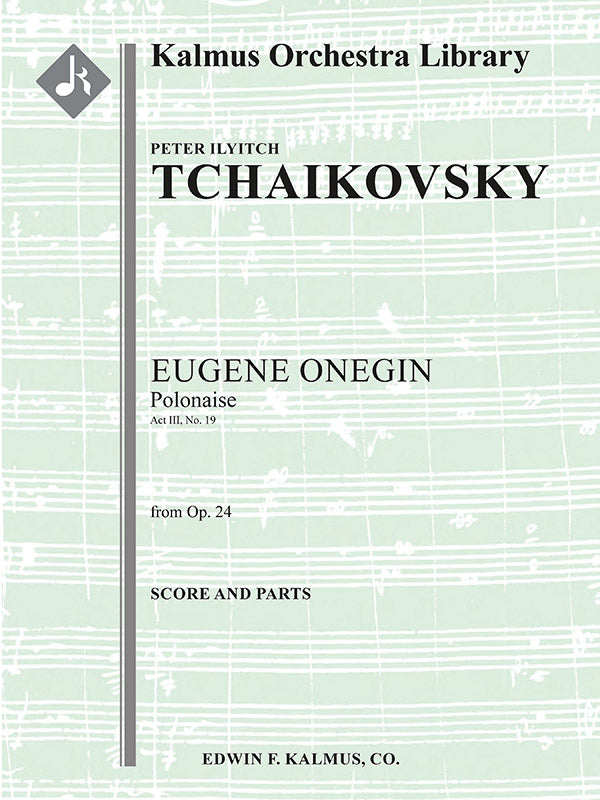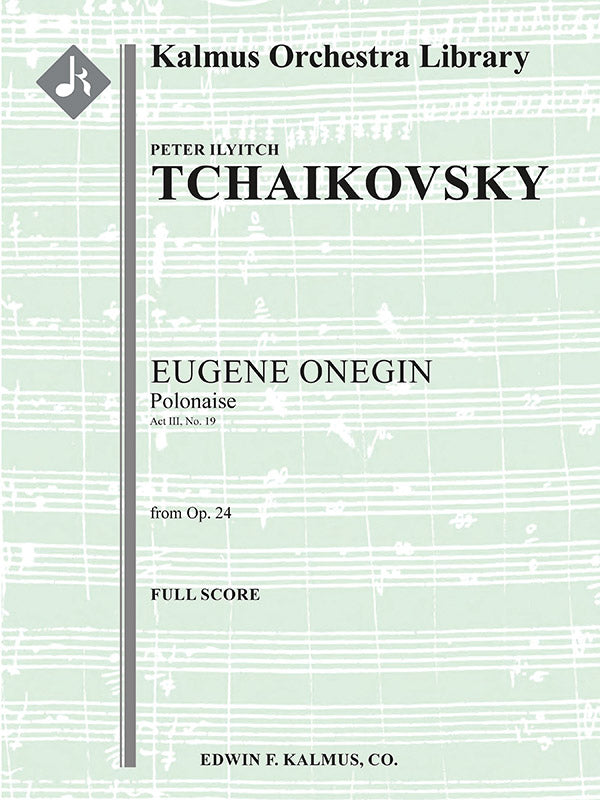Tchaikovsky: Polonaise from Eugene Onegin, Op. 24, No. 19
Expected to ship in about a week.
- Composer: Pyotr Ilyich Tchaikovsky (1840-1893)
- Instrumentation (this edition): Orchestra
- Originally for: Opera
- Work: Polonaise (Act III, No. 19) from Yevgeny Onegin (Eugene Onegin), ČW 5, Op. 24
- UPC:
Description
EUGENE ONEGIN, based on a verse-novel by Alexander Pushkin, is Peter Ilyitch Tchaikovsky's (1840-1893) best-known opera. The story depicts the life of the titular Onegin, a Russian dandy who does not understand himself, his emotions, or the value of life, leading him to reject an impassioned declaration of love by a woman he looks down upon and instead pursue the fiancée of his friend, who he kills in a duel as a result of this pursuit. The jubilant POLONAISE, a Polish folkdance that had become an art form for the concert hall by the 19th Century, is performed at a grand ball at the beginning of Act III, which marks the reappearance after five years of the woman Onegin had rejected so callously before, though she is now married to a prince, resulting in Onegin's new realization that he loves her. This development takes place against the musical background of the brilliant fanfares of the POLONAISE, fanfares that are appropriately offset by melancholy in the contrasting cello theme. This orchestral interlude has proven itself as popular as the full opera.
Instrumentation in set: 2.2.2.2: 4.2.3.0: Timp: Str (9-8-7-6-5).
Publishers use a lot of words to describe what they sell, and we know it can be confusing. We've tried to be as clear as possible to make sure you get exactly what you are looking for. Below are descriptions of the terms that we use to describe the various formats that music often comes in.
Choral Score
A score for vocalists that only contains the vocal lines. The instrumental parts are not there for reference. Generally, cheaper than a vocal score and requires multiple copies for purchase.
Facsimile
Reproductions of the original hand-written scores from the composer.
Full Score
For ensemble music, this indicates that the edition contains all parts on a single system (there are not separate parts for each player). In larger ensembles, this is for the conductor.
Hardcover
Hardbound. Generally either linen-covered or half-leather.
Orchestral Parts
Similar to a wind set, this is a collection of parts. In the case of strings, the numbers listed are the number of copies included, though generally these are available individually (often with minimum quantities required).
Paperback
When publishers offer multiple bindings (e.g. hardcover) or study scores, this is the "standard" version. If you're planning to play the music, this is probably what you want.
Performance / Playing Score
A score of the music containing all parts on one system, intended for players to share. There are not separate parts for each player.
Set of Parts
For ensemble music, this indicates that there are separate individual parts for each player.
Solo Part with Piano Reduction
For solo pieces with orchestra, this is a version that contains a piano reduction of the orchestra parts. For piano pieces, two copies are typically needed for performance.
Study Score
A small (think choral size) copy of the complete score meant for studying, and not playing. They make great add-ons when learning concertos and small chamber works.
Vocal Score
A score prepared for vocalists that includes the piano/organ part or a reduction of the instrumental parts.
Wind Set
For orchestral music, this is a collection of wind and percussion parts. The specific quantities of each instrument are notated.
With Audio
In addition to the printed music, the edition contains recordings of the pieces. This may be an included CD, or access to files on the internet.
With / Without Fingering (Markings)
Some publishers prepare two copies - a pure Urtext edition that includes no fingering (or bowing) suggestions and a lightly edited version that includes a minimal number of editorial markings.



